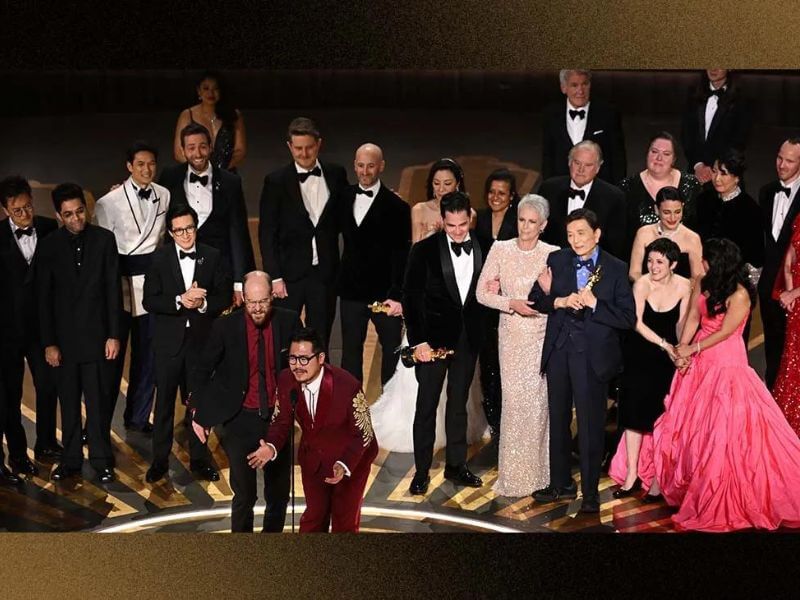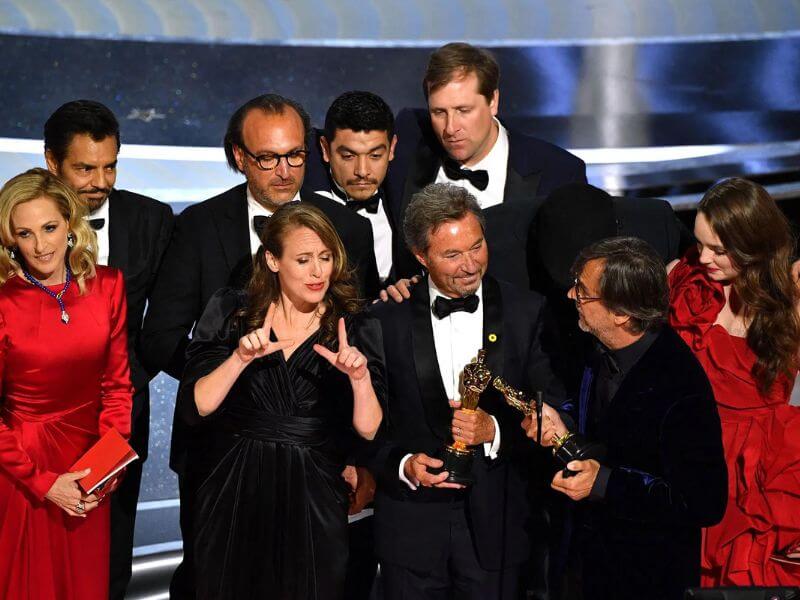Who accepted the Oscar for best picture? The Academy Award for Best Picture is one of the Academy Awards presented annually by the Academy of Motion Picture Arts and Sciences (AMPAS) since the awards debuted in 1929. This award goes to the producers of the film and is the only category in which every member of the Academy is eligible to submit a nomination and vote on the final ballot. The Best Picture category is traditionally the final award of the night and is widely considered the most prestigious honor of the ceremony.
The Grand Staircase columns at the Dolby Theatre in Hollywood, where the Academy Awards ceremonies have been held since 2002, showcase every film that has won the Best Picture title since the award’s inception. There have been 591 films nominated for Best Picture and 95 winners.
Who accepted the Oscar for best picture?
Daniel Kwan and Daniel Scheinert accepted the Oscar for Best Picture for Everything Everywhere All at Once on March 12, 2023.
The film is a science fiction action comedy that follows Evelyn Quan Wang, a Chinese-American laundromat owner who discovers that she is connected to parallel universes. She must use her newfound powers to save the world from an evil force.
Kwan and Scheinert are known for their unique and innovative filmmaking style. Their previous film, Swiss Army Man, was a critical and commercial success. Everything Everywhere All at Once is their most ambitious film to date, and it has been praised for its originality, humor, and heart.
The win for Everything Everywhere All at Once is a significant moment for Asian American representation in Hollywood. It is the first time that a film with a mostly Asian American cast has won Best Picture. It is also a reminder that Asian American stories are important and deserve to be told.

History
Category name changes
At the 1st Academy Awards ceremony held in 1929 (for films made in 1927 and 1928), there were two categories of awards that were each considered the top award of the night: “Outstanding Picture” and “Unique and Artistic Picture,” the former being won by the war epic Wings, and the latter by the art film Sunrise. Each award was intended to honor different and equally important aspects of superior filmmaking. In particular, The Jazz Singer was disqualified from both awards, since its use of synchronized sound made the film a sui generis item that would have unfairly competed against either category, and the Academy granted the film an honorary award instead.
The following year, the Academy dropped the Unique and Artistic Picture award, deciding retroactively that the award won by Wings was the highest honor that could be awarded, and allowed synchronized sound films to compete for the award. Although the award kept the title Outstanding Picture for the next ceremony, the name underwent several changes over the years as seen below. Since 1962, the award has been simply called Best Picture.
- 1927/28–1928/29: Academy Award for Outstanding Picture
- 1929/30–1940: Academy Award for Outstanding Production
- 1941–1943: Academy Award for Outstanding Motion Picture
- 1944–1961: Academy Award for Best Motion Picture
- 1962–present: Academy Award for Best Picture
Recipients
Until 1950, this award was presented to a representative of the production company. That year the protocol was changed so that the award was presented to all credited producers. This rule was modified in 1999 to apply a maximum limit of three producers receiving the award, after the five producers of Shakespeare in Love had received the award.
As of 2020, the “Special Rules for the Best Picture of the Year Award” limit recipients to those who meet two main requirements:
Those with screen credit of “producer” or “produced by”, explicitly excluding those with the screen credit “executive producer, co-producer, associate producer, line producer, or produced in association with” those three or fewer producers who have performed the major portion of the producing functions
The rules allow a bona fide team of not more than two people to be considered a single “producer” if the two individuals have had an established producing partnership as determined by the Producers Guild of America Producing Partnership Panel. Final determination of the qualifying producer nominees for each nominated picture will be made by the Producers Branch Executive Committee, including the right to name any additional qualified producer as a nominee.
The Academy can make exceptions to the limit, as when Anthony Minghella and Sydney Pollack were posthumously included among the four producers nominated for The Reader. As of 2014 the Producers Branch Executive Committee determines such exceptions, noting they take place only in “rare and extraordinary circumstance”
Steven Spielberg currently holds the record for most nominations at twelve, winning one, while Kathleen Kennedy holds the record for most nominations without a win at eight. Sam Spiegel and Saul Zaentz tie for the most wins with three each. As for the time when the Oscar was given to production companies instead, Metro-Goldwyn-Mayer holds the record with five wins and 40 nominations.

Best Picture and Best Director
The Academy Awards for Best Picture and Best Director have been closely linked throughout their history. Of the 95 films that have won Best Picture, 68 have also been awarded Best Director. Only six films have been awarded Best Picture without receiving a Best Director nomination: Wings directed by William A. Wellman (1927/28), Grand Hotel directed by Edmund Goulding (1931/32), Driving Miss Daisy directed by Bruce Beresford (1989), Argo directed by Ben Affleck (2012), Green Book directed by Peter Farrelly (2018), and CODA directed by Sian Heder (2021). The only two Best Director winners to win for films that did not receive a Best Picture nomination were during the early years of the awards: Lewis Milestone for Two Arabian Knights (1927/28), and Frank Lloyd for The Divine Lady (1928/29).
Nomination limit increased
On June 24, 2009, AMPAS announced that the number of films to be nominated in the Best Picture award category would increase from five to ten, starting with the 82nd Academy Awards (2009). Although the Academy never officially said so, many commenters noted the expansion was likely in part a response to public criticism of The Dark Knight and WALL-E (both 2008) (and, in previous years, other blockbusters and popular films) not being nominated for Best Picture. Officially, the Academy said the rule change was a throwback to the Academy’s early years in the 1930s and 1940s, when eight to 12 films were nominated each year.
“Having 10 Best Picture nominees is going to allow Academy voters to recognize and include some of the fantastic movies that often show up in the other Oscar categories but have been squeezed out of the race for the top prize,” AMPAS President Sid Ganis said in a press conference. “I can’t wait to see what that list of 10 looks like when the nominees are announced in February.”
At the same time, the voting system was switched from first-past-the-post to instant runoff voting (also known as preferential voting). In 2011, the Academy revised the rule again so that the number of films nominated was between five and ten; nominated films must earn either 5% of first-place rankings or 5% after an abbreviated variation of the single transferable vote nominating process.
Bruce Davis, the Academy executive director at the time, said, “A Best Picture nomination should be an indication of extraordinary merit. If there are only eight pictures that truly earn that honor in a given year, we shouldn’t feel an obligation to round out the number.” This system lasted until 2021, when the Academy reverted back to a set number of ten nominees from the 94th Academy Awards onward.
Language and country of origin
Only fourteen non-English language films have been nominated in the category: La Grande Illusion (French, 1938); Z (French, 1969); The Emigrants (Swedish, 1972); Cries and Whispers (Swedish, 1973); The Postman (Il Postino) (Italian/Spanish, 1995); Life Is Beautiful (Italian, 1998); Crouching Tiger, Hidden Dragon (Mandarin Chinese, 2000); Letters from Iwo Jima (Japanese, 2006, but ineligible for Best Foreign Language Film because it was an American production); Amour (French, 2012); Roma (Spanish/Mixtec, 2018); Parasite (Korean, 2019); Minari (Korean, 2020, but ineligible for Best International Feature Film because it was an American production); Drive My Car (Japanese, 2021) and All Quiet on the Western Front (German, 2022). Parasite became the first film not in English to win Best Picture.
Only ten films wholly financed outside the United States have won Best Picture, eight of which were financed, in part or in whole, by the United Kingdom: Hamlet (1948), Tom Jones (1963), A Man for All Seasons (1966), Chariots of Fire (1981), Gandhi (1982), The Last Emperor (1987), Slumdog Millionaire (2008), and The King’s Speech (2010). The ninth film, The Artist (2011), was financed in France and the tenth film, Parasite (2019), was financed in South Korea.
Rating
Since 1968, most Best Picture winners have been rated R under the Motion Picture Association’s rating system. Oliver! is the only G-rated film and Midnight Cowboy is the only X-rated (now NC-17) film, so far, to win Best Picture; they won in back-to-back years, 1968 and 1969. The latter has since been downgraded to an R rating. Eleven films have won with a PG rating: the first was Patton (1970) and the most recent was Driving Miss Daisy (1989). Eleven more films have won with a PG-13 rating (which was introduced in 1984): the first was The Last Emperor (1987) and the most recent was CODA (2021).
Who accepted Oscar for Best Movie 2023?
Daniel Kwan and Daniel Scheinert, the co-directors of Everything Everywhere All at Once, accepted the Oscar for Best Picture at the 95th Academy Awards ceremony on March 12, 2023. They are the first Asian-American directors to win Best Picture.
In their acceptance speech, Kwan and Scheinert thanked the Academy, their cast and crew, and their families. They also spoke about the importance of representation and diversity in Hollywood.
“This is for everyone who feels like they don’t belong,” Kwan said. “This is our movie.”
Scheinert added, “We want to thank everyone who made this movie possible. This is a film about the power of love, family, and community. Thank you for letting us share it with you.”
Everything Everywhere All at Once is a science fiction action comedy that follows Evelyn Quan Wang, a Chinese-American laundromat owner who discovers that she is connected to parallel universes. She must use her newfound powers to save the world from an evil force.
The film was a critical and commercial success, grossing over $236 million worldwide. It was praised for its originality, humor, and heart.
The win for Everything Everywhere All at Once is a significant moment for Asian American representation in Hollywood. It is the first time that a film with a mostly Asian American cast has won Best Picture. It is also a reminder that Asian American stories are important and deserve to be told.

Above is information about Who received the Oscar for best picture? Who has received? that we have compiled. Hopefully, through the above content, you have a more detailed understanding of Oscar for best picture. Thank you for reading our post.









